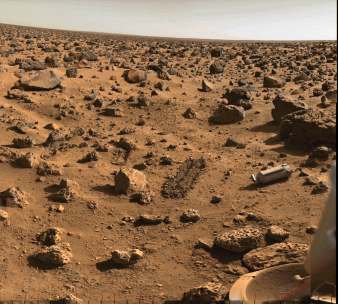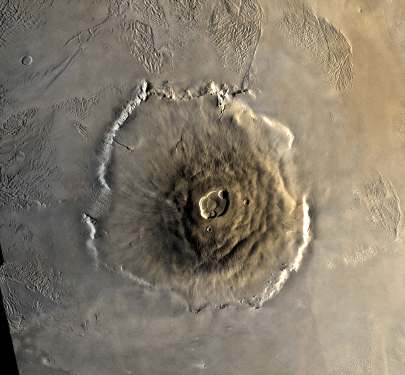 Mars is also extremely cold--at noon in summer, near the equator, the temperature may get above the freezing point of water, but barely, and so far, signs of liquid water are elusive (though temporary flows may follow comet impact). Gravity is about one-third of Earth's, which may explain why Mars retained much less atmosphere than our own planet did.
Mars is also extremely cold--at noon in summer, near the equator, the temperature may get above the freezing point of water, but barely, and so far, signs of liquid water are elusive (though temporary flows may follow comet impact). Gravity is about one-third of Earth's, which may explain why Mars retained much less atmosphere than our own planet did.
Note the reddish color of the ground, sign (here and in the US Southwest) for a high content of iron. Mars also appears red in the sky ("the red planet"), which is why a prominent reddish star in the constellation Scorpio was named "Antares"--the counterpart (anti-) of Ares, the Greek equivalent to Mars, god of war. The fast motion of Mars among stars at midnight suggested it was relatively close. Even before the invention of the telescope, Tycho tried to deduce its distance, using parallax methods and the change in position due to the Earth's rotation; he thought he had succeeded, but he was wrong.
Later, when Kepler's laws became known, it was realized that the answer would give the entire scale of distances in the solar system, and using a telescope, Jean Richer in 1672 obtained the first crude estimate of the distance of Mars.
Before astronomy had detailed information about Mars, it was widely held that life could exist on the red planet, or maybe actually did. Even through a good telescope, a 19th century observer of Mars could not resolve more detail than the unaided eye can of the Moon--and atmospheric variations ("twinkling") made the task even harder. Observers did agree about the polar caps and certain dark areas, but after that imagination often took hold. Some imagined seeing lines connecting darker areas--the famous "canals of Mars," supposedly belts of vegetation (like the Nile valley) along canals dug to distribute dwindling water resources.
Percival Lowell, an amateur astronomer, whole-heartedly believed the reality of a Mars civilization. In 1893-4 he constructed an observatory under the clear skies of Flagstaff, Arizona, and in 1895 he published the book "Mars," and later two more, with many maps showing those canals. Towards the end of his life (he died in 1916) he used his telescope to search for a new planet, and as will be seen, in 1930 it ultimately discovered Pluto.
 The notion of life on Mars also captured the imagination of fantasy fiction ("science fiction" was a later term). Edgar Rice Burroughs, creator of "Tarzan," wrote imaginative tales of a princess on Mars, now rightly forgotten. Herbert George ("H.G.") Wells wrote "The War of the Worlds" which is still very readable (a film version also exist). In 1938 Orson Wells dramatized "War of the Worlds" as a radio broadcast report of an alien invasion unfolding in New Jersey, panicking listeners who had missed its beginning and imagined it was a real event.
The notion of life on Mars also captured the imagination of fantasy fiction ("science fiction" was a later term). Edgar Rice Burroughs, creator of "Tarzan," wrote imaginative tales of a princess on Mars, now rightly forgotten. Herbert George ("H.G.") Wells wrote "The War of the Worlds" which is still very readable (a film version also exist). In 1938 Orson Wells dramatized "War of the Worlds" as a radio broadcast report of an alien invasion unfolding in New Jersey, panicking listeners who had missed its beginning and imagined it was a real event.
Is there life on Mars? The Viking landers (1976) conducted elaborate biochemical experiments and in the end found no proof. Recent interest was again aroused by some unusual meteorites recovered from the Antarctic icecap, said to have been ejected from Mars and containing tiny structures which some saw as fossils. So far, great doubt remains, but stay tuned.
Will human explorer set foot on Mars--say, before the end of this (21st) century? Again, very doubtful (see here about the orbital requirements). However, robot explorers have landed there and explored limited areas of the planet, powered by sunlight. Given expected progress in computer intelligence, this may prove a more fruitful approach. If humans ever fly to Mars, they will probably use one of the planet's tiny moons, Phobos and Deimos, as way stations, since landing there is much easier than on the planet itself. Perhaps even rocket fuel may be manufactured there, for the descent and the return trip. (And for science fiction buffs: look up Arthur Clarke's "Hide and Seek," whose action takes place on Phobos.)
The image above is of the volcano "Olympus Mons", rising about 25 km above Mars. Its height is made possible by the planet's weak gravity: if such a mountain were placed on Earth, its weight would cause its base to gradually sag, leaving a height comparable to that of terrestrial mountains.
Much more can be said about Mars (see tabulations). It has a great canyon (perhaps carved by comet impact, perhaps by rifting) with features attributed to flowing water, and also a moderate magnetic field which seems to originate fairly close to the surface.
|
 Mars is also extremely cold--at noon in summer, near the equator, the temperature may get above the freezing point of water, but barely, and so far, signs of liquid water are elusive (though temporary flows may follow comet impact). Gravity is about one-third of Earth's, which may explain why Mars retained much less atmosphere than our own planet did.
Mars is also extremely cold--at noon in summer, near the equator, the temperature may get above the freezing point of water, but barely, and so far, signs of liquid water are elusive (though temporary flows may follow comet impact). Gravity is about one-third of Earth's, which may explain why Mars retained much less atmosphere than our own planet did.
 The notion of life on Mars also captured the imagination of fantasy fiction ("science fiction" was a later term). Edgar Rice Burroughs, creator of "Tarzan," wrote imaginative tales of a princess on Mars, now rightly forgotten. Herbert George ("H.G.") Wells wrote "The War of the Worlds" which is still very readable (a film version also exist). In 1938 Orson Wells dramatized "War of the Worlds" as a radio broadcast report of an alien invasion unfolding in New Jersey, panicking listeners who had missed its beginning and imagined it was a real event.
The notion of life on Mars also captured the imagination of fantasy fiction ("science fiction" was a later term). Edgar Rice Burroughs, creator of "Tarzan," wrote imaginative tales of a princess on Mars, now rightly forgotten. Herbert George ("H.G.") Wells wrote "The War of the Worlds" which is still very readable (a film version also exist). In 1938 Orson Wells dramatized "War of the Worlds" as a radio broadcast report of an alien invasion unfolding in New Jersey, panicking listeners who had missed its beginning and imagined it was a real event.